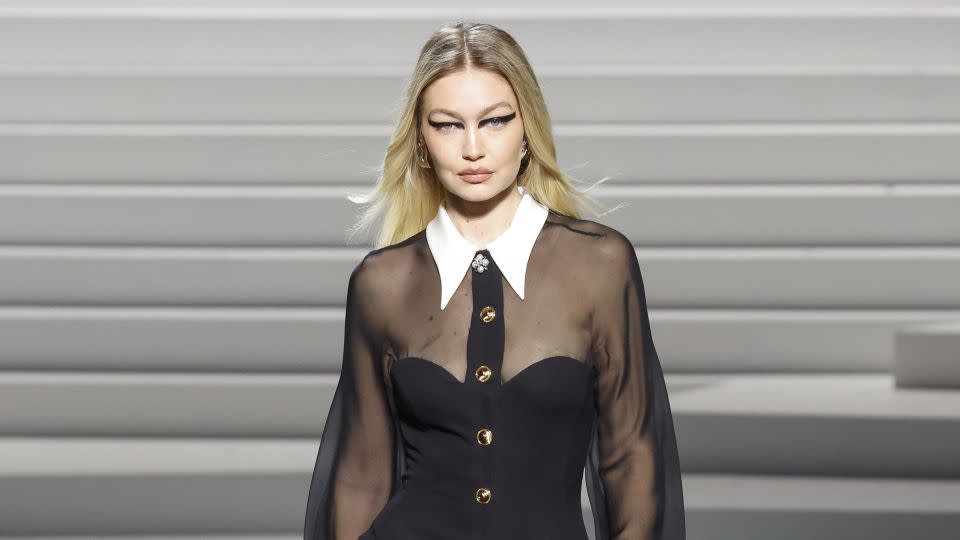Here are the trends that matter from Milan Fashion Week
Gimmicks were gone at the latest Milan runways — which concluded yesterday — with designers instead striking a more serious note that encouraged investment buying. Bold new directions appeared to be on pause, too, as fashion houses doubled-down on signatures that sell. A celebration of fashion it was not — rather a moment of reflection.
The schedule’s top-billing designers took the mic to stress the positive role fashion can play, while acknowledging — without being specific — the increasing turbulence the world is facing.
Backstage after her show, Miuccia Prada said that the starting point for her and co-creator Raf Simons was “an instinctive need for love and goodness… especially in a time like this.” Across town at a preview held in her office, Donatella Versace echoed that “living in the world we (do) today, we need the courage to move ahead, and fashion is a vehicle of positivity and togetherness”.

The industry veteran, Giorgio Armani, agreed: “We aren’t changing the world, nor can we solve the world’s problems, but we can give people a moment of lightness.” While Bottega Veneta’s Matthieu Blazy was the most direct when he proclaimed: “In a world on fire, there is something very human in the simple act of dressing… We all watch the same news. It is hard to be celebratory at this point. Still, the idea of rebirth is beautiful, too.”
Franken-style
That sentiment was most clearly echoed throughout the collections in what we’ll call Franken-styles: Part one thing, part another, stitched together to become a hybrid piece.


At Prada, what appeared to be a wool blazer from the front had a satin waistcoat back, while skirts were an apron-negligee combo. At Bottega Veneta, Blazy “combined and compressed” silhouettes from different eras and pinched dresses with pins, while at MSGM, Massimo Giorgetti — who based his collection on the destructive fall-out of Truman Capote’s “La Cote Basque” essay — had zips running around the body like stitches holding everything together, ready to unravel at any point.
The evolution of the twinset
The warped theme played into the twisted knitwear shown at Ferragamo, Fendi, Tod’s and Prada, which heralded the evolution of the twinset. More is more with knitwear next season as cardigans and jumpers arrived nonchalantly draped and layered together with controlled abandon.

Party feet
Breaking up the plethora of black leather boots that dominated most collections, the shoe of the season is one with embellishment all over it. At Dolce & Gabbana, ostrich features fluttered with each strut; at Jil Sander, stilettos were covered in black goat hair; and at Tod’s, new creative director Matteo Tamburini gave the famous Gommino driving shoe a makeover with all-over leather tassels.

1980s redux
Relegated as the style decade that people preferred to forget, the 1980s is slowly but surely starting to pop up on the radar. When Kim Jones found a 1984 sketch by Karl Lagerfeld in the Fendi archive, it sent him down a memory lane featuring the New Romantics and wardrobes of Leigh Bowery, Judy Blame and Princess Julia, referenced in the show with irregular polka dots and a subtle ode to his native London. “London was so influential in the world, influencing everyone designing at the time,” he said.


At Giorgio Armani, the designer opened his show with his 1980s muse Gina di Bernardo — who was shot in several of legendary photographer Aldo Fallai’s campaigns for the house in the period — taking to the runway. And Donatella Versace brought back the blazer she designed for musician Prince at the time — “something that would make him look taller” she said, with broad shoulders and a small waist.
Leather coats get a new lease of life
It’s a legacy winter style but that didn’t stop them from being everywhere this season — Ferragamo, Tom Ford, Bottega, Versace and Diesel, to mention a few. A continuation from the menswear shows in January, long, lean, and embellishment free is the memo for this trend that takes its leave from the Matrix.


As per Bottega Veneta: “Honesty in materiality and silhouette means the clothing is no longer pretending to be something other than what it really is: There is… comfort and protection in supple leather.”
Embracing the darkness
Save for pops of scarlet leather, the color palette in Milan was overwhelmingly dark and utilitarian for Fall-Winter 2024, with dark khaki and olive greens dominating (beautifully at Ferragamo and Tod’s).

Even at MaxMara, famed for its trademark camel, creative director Ian Griffiths went in a deliberately different direction to focus on silhouette over shade. “It was good to free myself of camel for a season and I couldn’t have done these clothes in camel,” he said backstage. “We’re not abandoning it, we’re just giving it a rest, and it’s a rest for me, too.”
Denim came dark, too. Next season it’s all about double selvedge-style denim that is clean cut and precisely pressed.
Craft over clickbait
With a clear focus on unconfrontational fashion throughout the weeks’ worth of shows — save for the very last at Avavav that saw garbage thrown at models on the runway and the brand leaning into its bad reviews with a rolling commentary on screens either side — a sense of preservation hung in the air. Milan’s designers focused on exquisite craft over clickbait, not so much reinventing the wheel, but keeping it rolling.










For more CNN news and newsletters create an account at CNN.com


